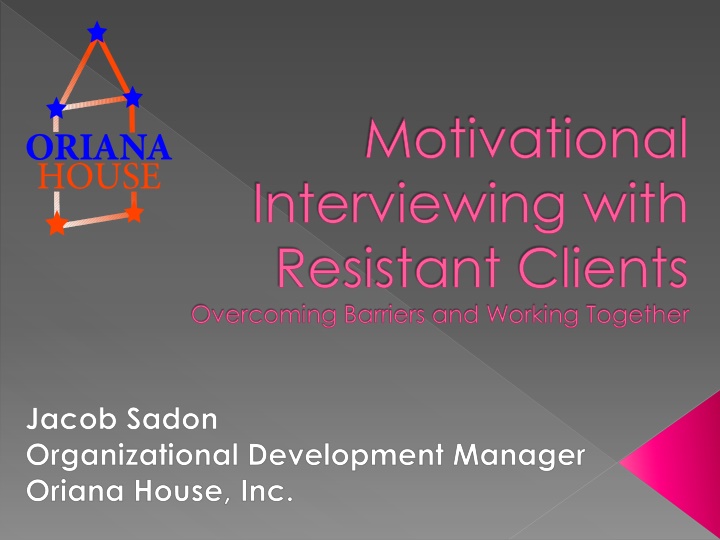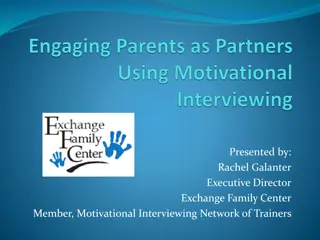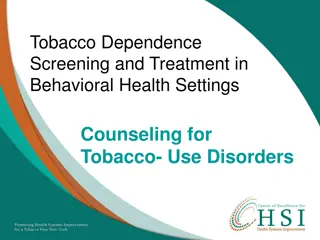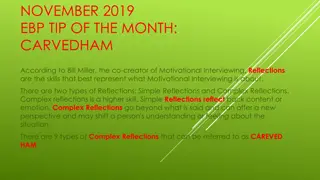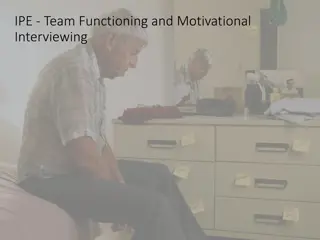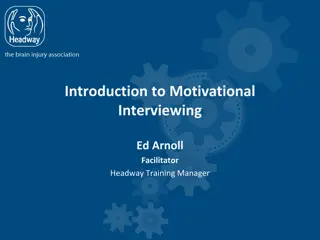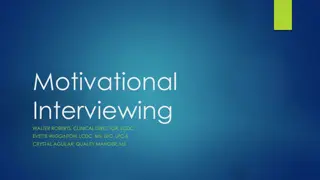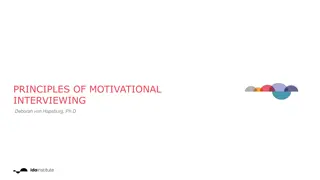Motivational Interviewing for Resistant Clients: Overcoming Barriers
Principles and techniques of Motivational Interviewing for working with resistant clients. Learn how to form a collaborative relationship and focus on client autonomy to facilitate change effectively.
Download Presentation

Please find below an Image/Link to download the presentation.
The content on the website is provided AS IS for your information and personal use only. It may not be sold, licensed, or shared on other websites without obtaining consent from the author.If you encounter any issues during the download, it is possible that the publisher has removed the file from their server.
You are allowed to download the files provided on this website for personal or commercial use, subject to the condition that they are used lawfully. All files are the property of their respective owners.
The content on the website is provided AS IS for your information and personal use only. It may not be sold, licensed, or shared on other websites without obtaining consent from the author.
E N D
Presentation Transcript
Motivational Interviewing with Resistant Clients Overcoming Barriers and Working Together Jacob Sadon Organizational Development Manager Oriana House, Inc.
Goal Review and understand the basic principles of Motivational Interviewing and their application with especially resistant clients.
Objectives Define Motivational Interviewing Discuss the Spirit of MI Examine MI Principles Examine MI Techniques ALL ABOUT THE RESISTANT CLIENT!
What is it? A style of communication and interaction with a client to help them become more motivated for change
Vent About Resistant Clients *professionally
Really? Do you think that our interactions and communication style can really affect a client s change process? Examples
Spirit of MI Forming a relationship with a client that is collaborative and engaging while focusing on the client s autonomy Spirit vs. techniques
Collaborative Collaborative relationship with clients Professional relationship with a client in which both parties take an active role in the change process
Collaborative What does it mean for both parties to take an active role in case management?
Collaborative Is a collaborative relationship everyone s strength? Examples of non-collaborative relationships? Things people say or do
Collaborative vs Confronting Client: I need to get a job, I don t have time for all these classes. I got tons of bills to pay. Agent: There is a lot on your plate right now. Let s talk about what the classes are about, their timeframes, and come up with a path that seems realistic to you.
Collaborative vs Confronting Client: I need to get a job, I don t have time for all these classes. I got tons of bills to pay. Agent: Your ORAS is high risk so these classes are mandatory, no way around it.
Collaborative Relationship must be collaborative for MI to work And for change to happen
Spirit of MI Forming a relationship with a client that is collaborative and engaging while focusing on the client s autonomy
Engaging Making the client an active participant Active participant in what?
Engaging Premise is that the client has reasons and resources for behavior change but it is our job to help the client realize and acknowledge them Again collaborative
Spirit of MI Forming a relationship with a client that is collaborative and engaging while focusing on the client s autonomy
Client Autonomy Qu es esto? Responsibility for and choice to change behavior is solely that of the client
Client Autonomy Why does this matter? Client s choice to change More buy in Less long-term resistance You will not always be there
Autonomy vs. Authoritarian Client: I don t want to quit smoking dope, but I m in this program so I know I have to. Agent: You have the choice the continue smoking dope. But it is certainly a rule here so there are consequences for the decisions you make.
Autonomy vs. Authoritarian Client: I don t want to quit smoking dope, but I m in this program so I know I have to. Agent: It is a major rule here, so you cannot smoke dope while in this program.
Spirit of MI Forming a relationship with a client that is collaborative and engaging while focusing on the client s autonomy
Spirit of MI Being open to the spirit of MI is the first major step in implementing MI
Avoiding Common Resistance Traps What traps can we fall in that act as barriers to the spirit of MI?
Responding to Resistance Resistance traps Closed question cycle Righting reflex Premature focus Taking sides Blaming Know-it-all Labeling Rush
Resistance Traps Closed question cycle Asking repeated closed questions Increases resistance Feel interrogated
Resist the Righting Reflex Righting reflex Trying to fix everything ourselves Noble, but also dangerous
Resist the Righting Reflex What do you do when someone tries to right you? We make quick counter arguments in our heads.
Resistance Traps Premature Focus Client may focus on a different issue than the staff member at first Client may become defensive Let the client take the lead
Resistance Traps Taking Sides Confronting the client with opposing view Does not allow for client autonomy
Resistance Traps Blaming Not here to identify fault Here to identify solutions
Resistance Traps Know-it-all Employee does not have all the answers Collaboration is the only way
Resistance Traps Labeling Don t insist on a diagnostic label Criminal, addict, etc. When we feel stigmatized we get defensive
Resistance Traps Rush Be patient Change doesn t have to happen in 1 meeting Conveys a lesser importance
Responding to Resistance Respond with nonresistance Reflect back, objectively Acknowledging the resistance is different than condoning it or dismissing it
Responding to Resistance Reflecting back can allow a client to explore their behavior even more Sometimes an amplified reflection may help
Responding to Resistance Don t worry about power Safety yes, power trip no Don t appease Don t use humor
Responding to Resistance Sustain Talk Different than resistence
Responding to Resistance Shifting focus: bypassing the topic the client is resisting and shift to another important topic When might this be helpful?
Responding to Resistance Coming alongside: acknowledging that the client may choose not to change their behavior When might this be helpful?
Responding to Resistance Amplified reflection: reflect back what the client said, but intensify it Client: Quitting drinking is not something I ve considered Agent: Drinking is something you will definitely continue to do while here?
Responding to Resistance Emphasize personal choice: put the responsibility for change on the client, get away from do as I say When might this be helpful?
Responding to Resistance Reframe: offer a different interpretation of what the client is saying When might this be helpful?
Responding to Resistance Agreement with a twist: a reflection followed by a reframe When might this be helpful?
Understanding Change Change is scary Change is gradual Change is a process, not an event
Understanding Change YOU would be scared YOU would change gradual YOUR change is a process, not an event
MI Principles Understand and Explore the Person s Own Motivations Listen with Empathy Empower the Client
Understand and Explore the Client s Own Motivations Motivation must come from the client Why not from you? Time is an investment that pays dividends!
